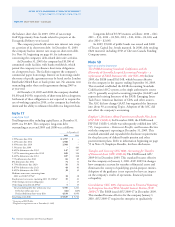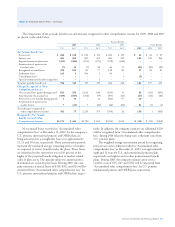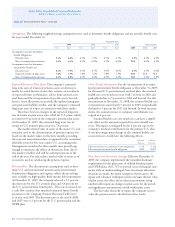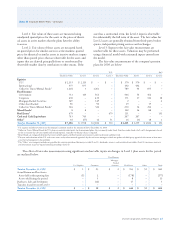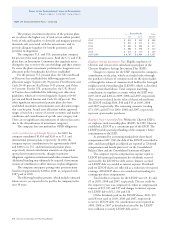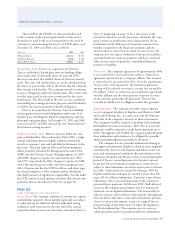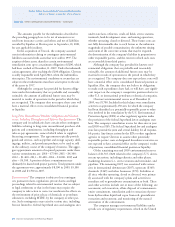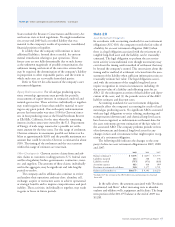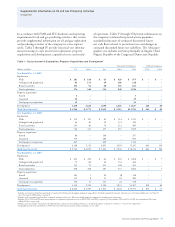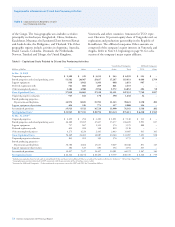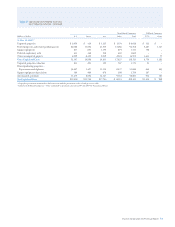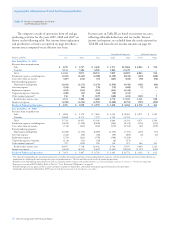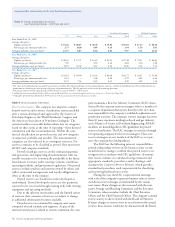Chevron 2009 Annual Report Download - page 68
Download and view the complete annual report
Please find page 68 of the 2009 Chevron annual report below. You can navigate through the pages in the report by either clicking on the pages listed below, or by using the keyword search tool below to find specific information within the annual report.
66 Chevron Corporation 2009 Annual Report
FS-PB
The amounts payable for the indemnities described in
the preceding paragraph are to be net of amounts recov-
ered from insurance carriers and others and net of liabilities
recorded by Equilon or Motiva prior to September 30, 2001,
for any applicable incident.
In the acquisition of Unocal, the company assumed
certain indemnities relating to contingent environmental
liabil ities associated with assets that were sold in 1997. The
acquirer of those assets shared in certain environmental
remediation costs up to a maximum obligation of $200, which
had been reached at December 31, 2009. Under the indemnifi-
cation agreement, after reaching the $200 obligation, Chevron
is solely responsible until April 2022, when the indemnifica-
tion expires. The environmental conditions or events that are
subject to these indemnities must have arisen prior to the sale
of the assets in 1997.
Although the company has provided for known obliga-
tions under this indemnity that are probable and reasonably
estimable, the amount of additional future costs may be
material to results of operations in the period in which they
are recognized. The company does not expect these costs will
have a material effect on its consolidated financial position
or liquidity.
Long-Term Unconditional Purchase Obligations and Commit-
ments, Including Throughput and Take-or-Pay Agreements The
company and its subsidiaries have certain other contingent
liabilities relating to long-term unconditional purchase obli-
gations and commitments, including throughput and
take-or-pay agreements, some of which relate to suppliers’
financing arrangements. The agreements typically provide
goods and services, such as pipe line and storage capacity, drill-
ing rigs, utilities, and petroleum products, to be used or sold
in the ordinary course of the company’s business. The aggre-
gate approximate amounts of required payments under these
various commitments are: 2010 – $7,500; 2011 – $4,300;
2012 – $1,400; 2013 – $1,400; 2014 – $1,000; 2015 and
after – $4,100. A portion of these commitments may
ultimately be shared with project partners. Total payments under
the agreements were approximately $8,100 in 2009, $5,100
in 2008 and $3,700 in 2007.
Environmental The company is subject to loss contingen-
cies pursuant to laws, regulations, private claims and legal
proceedings related to environmental matters that are subject
to legal settlements or that in the future may require the
company to take action to correct or ameliorate the effects on
the environment of prior release of chemicals or petroleum
substances, including MTBE, by the company or other par-
ties. Such contingencies may exist for various sites, including,
but not limited to, federal Superfund sites and analogous sites
under state laws, refineries, crude-oil fields, service stations,
terminals, land development areas, and mining operations,
whether operating, closed or divested. These future costs are
not fully determinable due to such factors as the unknown
magnitude of possible contamination, the unknown timing
and extent of the corrective actions that may be required,
the determination of the company’s liability in proportion to
other responsible parties, and the extent to which such costs
are recoverable from third parties.
Although the company has provided for known envi-
ronmental obligations that are probable and reasonably
estimable, the amount of additional future costs may be
material to results of operations in the period in which they
are recognized. The company does not expect these costs will
have a material effect on its consolidated financial position or
liquidity. Also, the company does not believe its obligations
to make such expenditures have had, or will have, any signifi-
cant impact on the company’s competitive position relative to
other U.S. or international petroleum or chemical companies.
Chevron’s environmental reserve as of December 31,
2009, was $1,700. Included in this balance were remediation
activities at approximately 250 sites for which the company
had been identified as a potentially responsible party or other-
wise involved in the remediation by the U.S. Environmental
Protection Agency (EPA) or other regulatory agencies under
the provisions of the federal Superfund law or analogous state
laws. The company’s remediation reserve for these sites at year-
end 2009 was $185. The federal Superfund law and analogous
state laws provide for joint and several liability for all responsi-
ble parties. Any future actions by the EPA or other regulatory
agencies to require Chevron to assume other potentially
responsible parties’ costs at designated hazardous waste sites are
not expected to have a material effect on the company’s results
of operations, consolidated financial position or liquidity.
Of the remaining year-end 2009 environmental reserves
balance of $1,515, $820 related to the company’s U.S. down-
stream operations, including refineries and other plants,
marketing locations (i.e., service stations and terminals), and
pipelines. The remaining $695 was associated with various
sites in international downstream ($107), upstream ($369),
chemicals ($149) and other businesses ($70). Liabilities at
all sites, whether operating, closed or divested, were primar-
ily associated with the company’s plans and activities to
remediate soil or groundwater contamination or both. These
and other activities include one or more of the following: site
assessment; soil excavation; offsite disposal of contaminants;
onsite containment, remediation and/or extraction of petro-
leum hydrocarbon liquid and vapor from soil; groundwater
extraction and treatment; and monitoring of the natural
attenuation of the contaminants.
The company manages environmental liabilities under
specific sets of regulatory requirements, which in the United
Note 22 Other Contingencies and Commitments – Continued
Notes to the Consolidated Financial Statements
Millions of dollars, except per-share amounts


